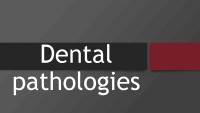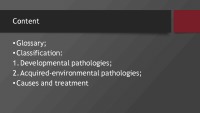Dental Pathologies



Dental. Pathologies. Content. Glossary. Dental pathologies. Developmental pathologies. Teeth number anomalies. Hypodontia. Teeth number anomalies. Hyperdontia. Size abnormalities. Microdontia. Size abnormalities. Macrodontia. Positional pathologies. Transposition. Morphological anomalies. Concrescence. Morphological anomalies. Fusion. Morphological anomalies. Gemination. Taurodontism. Dilaceration. Supernumerary Roots. Dens Evaginatus. Dens Invaginatus – Dens in dente. Impacted teeth. Acquired pathologies. Acquired disorders. Tooth Ankylosis. Acquired disorders. Resorption. Acquired disorders. Hypercementosis. Acquired disorders. Pulp stone. Acquired disorders. Attrition. Acquired disorders. Abrasion. Acquired disorders. Erosion. Causes and treatment. Match picture with the right dental pathology. Finish sentences. Sources.
Glossary; Classification: Developmental pathologies; Acquired-environmental pathologies; Causes and treatment.
Uncommon with primary teeth; Affects women more that men; Most commonly missing teeth: third molars,maxillary and mandibular second premolars, mandibular central incisors. Orthodontic treatment, protheses.
Smaller teeth; Relative microdontia – bigger jaw, spacing between teeth; Generalized microdontia is uncommon; Single microdontia is mostly seen in maxillary lateral incisors; Solitary microdontia involves maxillary lateral incisors and third molar; Treatment is not necessary (porcelain restorations).
Megalodontia/megadontia; Larger teeth than normal (not teeth with normal size placed in a small jaw); Generalized macrodontia may be along with gigantism; Localized macrodontia may be seen in facial hemihypertrophy. Treatment not needed (unless for esthetics).
Teeth are not in proper position in dental arch; Common in canines, first premolars and lateral incisors; Not common in primary teeth; Associated with hypodontia, hyperdontia and remaining deciduous teeth;.
Roots of two or more teeth are attached; Both primary and permanent teeth can be affected; Mostly involves maxillary molars; Causes – lack of spaces, trauma, abnormal occlusal forces, local infections during development. Treatment not needed (unless it results delayed eruption – surgical extraction).
Arises from union of tooth germs; Connects to each other befor calcification; Results the decrease in teeth number; Involves primary and permanent teeth; Tooth size varies; Lateral incisor-canine and central incisor-lateral incisor Extraction only for eruption problems prevention.
- Medicine Presentations
- MS PowerPoint 5178 KB
- 2019 m.
- English
- 36 pages (1164 words)
- University
- Kristė

















